YouTube: How to plant a bamboo hedge or screen
YouTube: Clumping bamboo, its uses, growing tips, care & pruning.
How to grow a Bamboo Screen in 9 easy steps
Are you tired of struggling to find the perfect solution for landscaping your garden? It can be frustrating to search through countless options, only to end up with results that don’t meet your expectations. And let’s face it, who has the time and patience to deal with plants that grow out of control and require constant maintenance?
Introducing Slender Weavers, the ultimate landscaping choice for gardeners like you. This fast-growing bamboo variety is specifically designed to reach a maximum height of 8 meters, making it the preferred choice for many professional landscapers. With its lush evergreen foliage, vibrant green stems, and shallow root structure, Slender Weavers provides the ideal solution for your gardening needs.
Imagine a garden filled with beautifully arranged Slender Weavers, creating a stunning visual impact while requiring minimal effort to maintain. Say goodbye to the hassle of dealing with unruly plants that take over your garden and hello to a landscape that is both visually appealing and easy to manage.
Don’t wait any longer to transform your garden into the oasis you’ve always dreamed of. Take advantage of this limited-time opportunity to get your hands on Slender Weavers and start enjoying the benefits it brings to your landscaping projects. Act now and experience the difference for yourself.
Get ready to impress your friends and neighbors with a garden that stands out from the rest. Choose Slender Weavers and say goodbye to landscaping problems once and for all.
How To Grow A Bamboo Screen in 9 Steps
How To Grow A Bamboo Screen in 9 Steps
Total Time Needed :
30
Minutes
Total Cost:
65
USD
Required Tools:
Things Needed?
Steps to configure the How-to Schema:
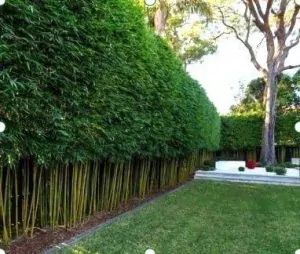

For a bamboo screen, in almost all cases Slender Weavers is the best option, hence the title: How to Grow a Slender Weavers Bamboo Screen
Slender Weavers, also called Gracilis quickly forms a privacy screen of bamboo and is not too big for most people’s needs.
Here are some tips for getting a beautiful bamboo privacy screen as soon as possible.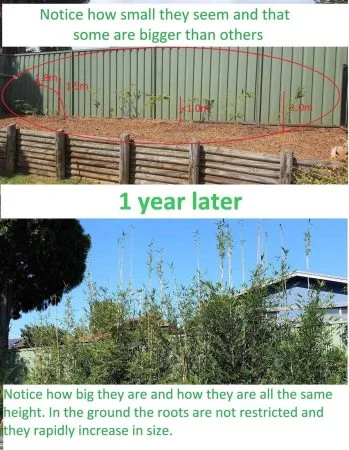

Be very careful when buying bamboo, make sure it is not rootbound.
Bamboo grows by putting up taller and taller culms (shoots –> canes)
It may be tempting to look for plants that have 6 culms well over 1.5m in a 200mm pot but the question is why are they all the same size? Why aren’t the culms increasing in size?
Answer: It is rootbound and has run out of space.
It is now suffering from the Bonsai effect and has begun to enter into a phase of stunted growth, which is very hard to get them out of.
The bamboos we sell will all have a series of increasingly taller culms, meaning that you know that the next one is going to be bigger than the last. Sometimes twice the height when they are put in the ground.
We only sell plants with a healthy root system that can establish in the ground.
Look at these photos and notice that initially, the bamboos are all different heights but they are all fairly small.
If bamboo needed to be big to grow quickly then these photos wouldn’t be possible.
There are two things that make a difference in how big bamboo will be in the future
1) the size of the root system (size of the pot) providing it is not rootbound
2) The time spent growing in the ground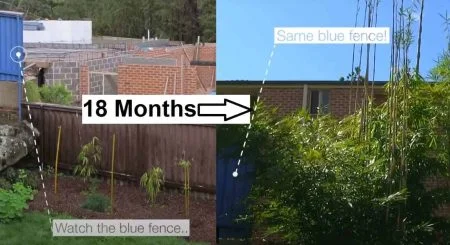

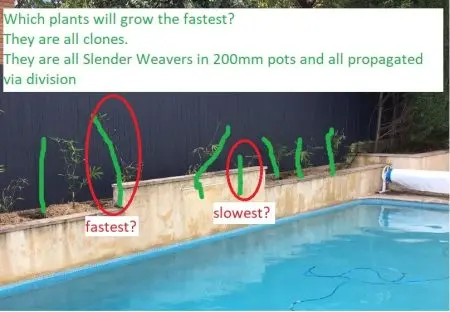

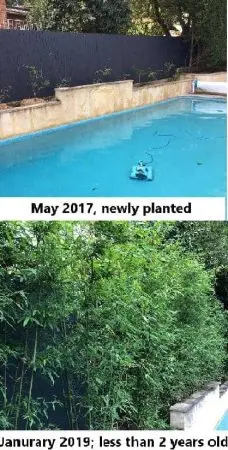



The last photos were sent from a customer who thanked us for explaining all this to him in a way that made sense because he was new to bamboo and simply couldn’t understand how plants that size could possibly grow that fast
The other reason we don’t (and wouldn’t) sell them when they are overgrown is that they actually never hang around long enough.
Most people notice that we advise buying fewer plants to give each individual plant more space because more volume for the roots = faster growth and bigger plants, and that is exactly the same reasoning behind not selling big plants in small pots.
As far as we are aware, it’s pretty difficult to get nurseries to explain this, but wherever you buy bamboo, make sure the roots are not compacted and make sure you buy from a specialist bamboo nursery that can explain the way they grow and give you proper advice.
We have been doing this since 2012 and the information on this site is simply what we have learnt (through making mistakes ourselves, so you don’t have to !)
Choose the right bamboo for the right reason and always remember why you are buying it because how it looks now will be irrelevant in 3 years.
Slender Weavers has earnt a reputation for all the right reasons.
– a perfect bamboo plant for Sydney’s climate especially if you need privacy screening.
– very small footprint and can be planted in small areas
– extremely fast-growing
– Doesn’t get taller than 6-8m
– Frost hardy (down to below -10C)
– Drought hardy
– Easy to keep at a lower height
– Easy to maintain but cutting down and/or thinning out
– Looks good all year round
– very adaptable to a wide range of conditions
– easy to cut some culms to force leaves out at a lower height
– easy to keep looking neat and tidy if 8m tall with weeping tops is too big for you
It’s hard to think of any more qualities you want in bamboo to screen the neighbours in 2 years.
Growing a bamboo screen serves many purposes.
Privacy is usually the number one reason for growing a bamboo screen but there are other benefits that are often overlooked.
– They can be used to add appeal to your landscape.
– Security
– Wind barriers
– Noise reduction
– Pollution reduction
– Blocking the view of whatever is you don’t like looking at
– Stopping people looking in at you (we get a lot o people with shocking stories of neighbours, some people want bamboo with thorns, but we don’t have any)
-Materials for making crafts and wooden products.
– Some shoots are edible
– Some of the timber is strong enough to be useful for temporary fixtures and fittings
– Some bamboo can be used for building houses, but that’s something best left to people who know what they are doing. certainly the
Colombians have figured out how to grow their own house. Buy the land, plant bamboo and wait a few years and then build a house.
You may want a smaller or bigger bamboo screen for privacy or noise reduction.
With all that………. Choose the right bamboo for what you want it to look like in 2,3,4,5 years’ time and ask plenty of questions.
If you want a privacy screen then Slender Weavers are usually the best choicelick here to change this text. Lorem ipsum dolor sit amet, consectetur adipiscing elit. Ut elit tellus, luctus nec ullamcorper mattis, pulvinar dapibus leo.
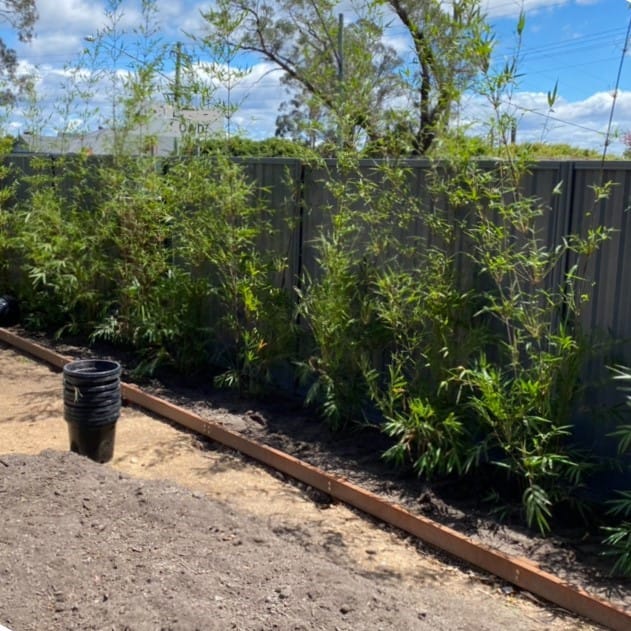

The spade has been chosen for a reason…..
Many people believe that digging over the soil is beneficial and it actually isn’t unless there is a reason.
If other plants are growing where you want to plant the bamboo, you can just plant the bamboo and water it until it’s established as other plants signify healthy soil.
It will grow very quickly and look great.
Bamboo is NOT some plant that needs specialist care like an orchid.
You do NOT need expert knowledge to grow it.
However, many of our customers want a screen quickly and want it to look amazing
.
This is easy to encourage by following the guidelines below (these are guidelines.. NOT rules)
They can make a significant difference, depending on the current state of your soil.
If your soil is already in excellent then the guidelines will have less effect than if the soil is in very poor condition.
These guidelines will encourage the right microbes to grow
Download Care Guidelines

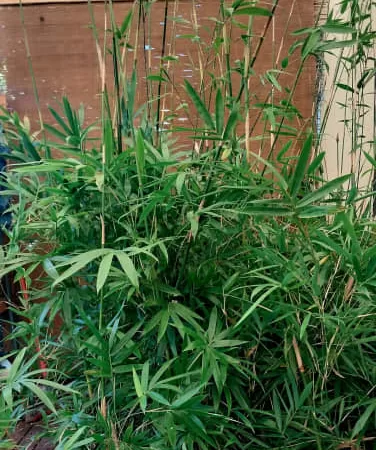

It’s very important to understand that plants have adapted to grow in soil.
That means soil is in its natural condition, free from human influence.
So, you want to aim to recreate the natural conditions and modify some of the factors that promote fast growth.
Nature will take care of the rest of it for you.
If you want a privacy screen of bamboo then you want to keep it as natural as possible.
It will look beautiful as a result.
Free-draining soils are important but if you have other plants growing nearby then the soil is likely fine.
If in doubt dig the planting holes then fill them with water. If the water is still in the hole after 6-12 hours (very rare) then you need to improve the drainage.
Contact us if you need advice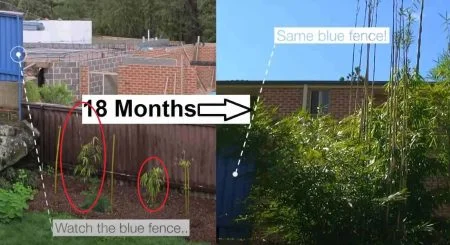

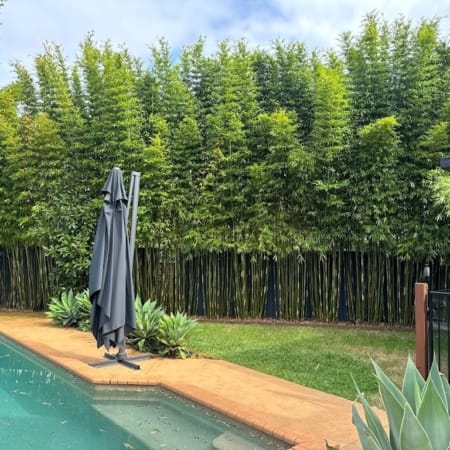

Sydney is increasing in population density and many customers buy bamboo plants to grow into a privacy screen to block out the new build next door.
Generally, the new build and bamboo tend to mature about the same time so if the bamboo plants are planted early enough, then you will have a bamboo privacy screen right in time.
Allow the bamboo to grow to the height you want. Then let the new shoots grow up and form culms (canes).
Just before they start to put out leaves, bend them down (easier and safer than a ladder) and cut them a bit below the height you want
.
That culm, once cut, will never grow any taller. It will put out more leaves at the lover sections than if it were uncut.
If you want a ground-to-top screen with foliage all the way up the best thing to do is to cut 1/3rd of the culms to about 1/3rd of the height of the screen.
This forces them to put out more leaves lower down.
This way you get foliage for the top 2/3rd from the taller culms and foliage for the bottom 1/3rd from the cut culms.
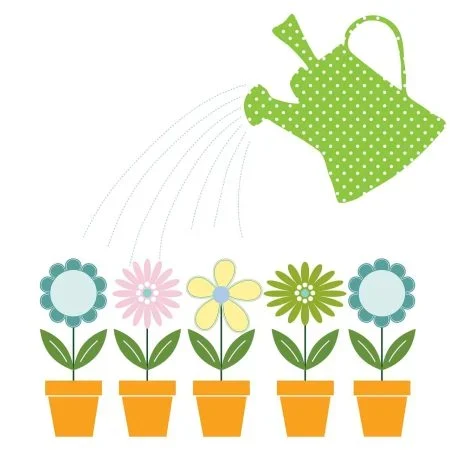

Once bamboo plants are established they are more hardy and tolerant of cool temperatures, drought, winds and other environmental factors.
Ensuring that you can meet their water requirements is important in getting them to this stage but no more so than any other plant.
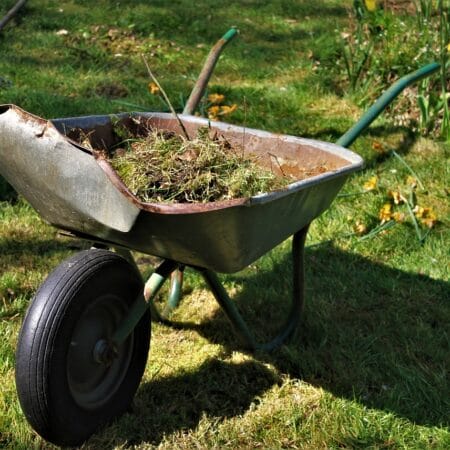

Start with some good organic material and then cover that with a hardwood chip.
How to mulch bamboo plants: Bamboo plants love mulch so regardless of adding anything else, always aim to use some mulch.
It modulates the soil temperature and moisture which is really beneficial for microbial activity..
We would recommend putting a thin layer now (1-2cm) while they are young and then when they are bigger you can increase the depth if you wish.
Keep the mulch topped up all around the plant.
This keeps the bamboo happy and it will put out more leaves, more quickly to form a screen.
More space, more growth, much faster growth.
Save money, don’t squeeze them so tightly together. 1.3m is a good distance to keep them apart.
You can go up to 1.5m fairly easily, beyond that it may start to push things a bit and cause you some more work with your pruning and cause gaps early on, but with a bit of work, it will all be just fine.
Give us a call, send us an email and we can help you
Above all, remember that the soil is your best friend.
Treat it nicely and it will look after the bamboo for you (*drought years can be difficult but I have only had to water bamboo in the ground once since 2012)
If your soil looks like it could be improved, add organic matter ON TOP of the soil and let it rot down naturally.
It will only benefit the plant when it’s ready to be incorporated into the soil.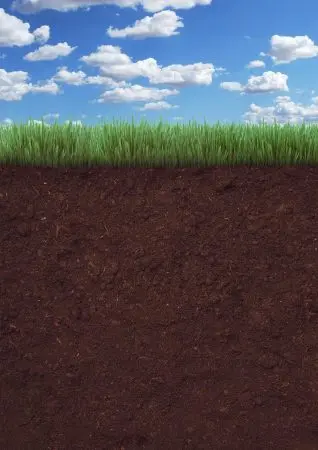



Encourage the growth of microbes in the soil, particularly fungi.
We were all taught that trees have as many roots below the ground as they do leaves above it.

Except that’s only a small part of the picture.
The roots form a mutualistic, symbiotic relationship with fungi in the soil called mycorrhizae.
The plants give the fungi sugars and in exchange, the fungi draw up water and nutrients from, deep underground.
It benefits the fungi by keeping the plant alive and the fungi live in all soils, all soils that haven’t been drenched in chemical fertilisers (for example).
The fungi increase the effective surface area of the roots massively.
All you need to do is keep the bamboo fed and watered.
You can feed the fungi by regularly adding compost, manure and mulch and letting it break down ON TOP of the soil.
The worms and other invertebrates will decide when it’s ready to take down 🙂
With mycorrhizae

Without mycorrhizae and with mycorrhizae

Generally, do NOT add anything INTO the soil.
In the natural environment, things rot on the ground, are broken down and become part of the soil.
You will never find manure, compost or blood and bone mixed in with the soil in nature but you will find organic materials like this ON the soil.
Manure, Compost (both must be well-rotted) and Blood and Bone work really well if you put them ON TOP of the soil.
Put mulch on top of that and water it to help it break down.
Hardwood chip mulch lasts the longest as mulch.
Microbial and invertebrate action will enrich your soil from the top ground (which is how it happens naturally)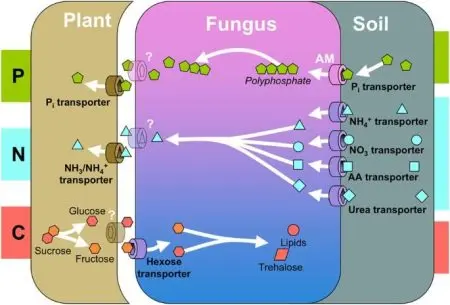

This will happen gradually over time and you can’t really force it, let nature take its course.
The bamboo will grow well and will thank you for it in a year or two by growing faster and faster.
Blood and Bone seems to attract some dogs so if you have dogs and don’t want your newly planted bamboo to be dug up then AVOID blood and bone.*
Do NOT dig in potting mix with the soil. Potting mix works well in pots, whereas soil is a very poor medium for growing in pots.
It sounds counter-intuitive but it’s easy to find out by trying to grow (very cheap) plants in soil in pots.
Then compare them to the same plants growing in potting mix in pots and you will see the difference.
For the same reason, digging potting mix in the soil generally is not a good idea.
More detail found in our Care Guidelines
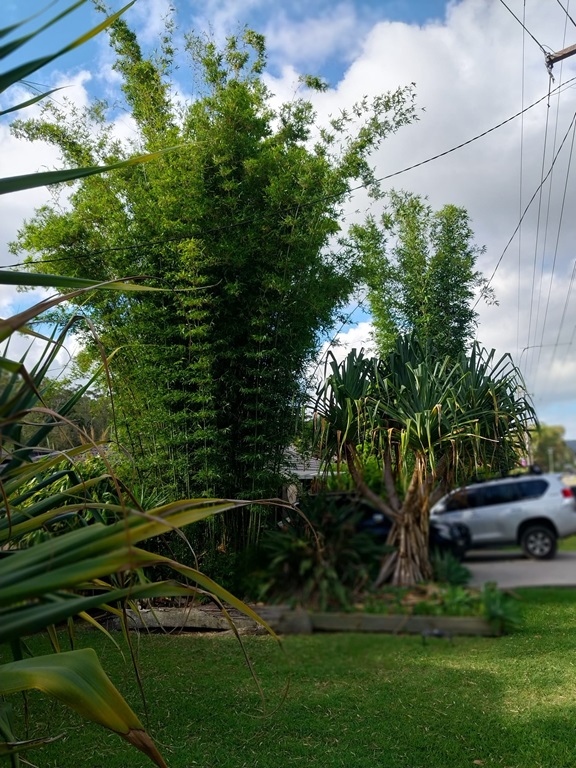

As with all plants that grow in normal soil conditions, do not over-water bamboo plants when young for extended periods.
If your soil drains well then this isn’t likely to be a problem.
The key is to understand that roots actually need oxygen from the air so waterlogged soil prevents the air from reaching the roots through the soil.
Soggy soil also promotes anaerobic microbes, which are not healthy and young plants (of all types) do not seem to enjoy growing in a swamp for very long.
The rule of thumb is little and often with water to start with.
Aim to keep the roots and the surrounding soil moist but NOT soggy
Once a week give them a deep water to encourage deeper root growth.
If you have days of torrential rain then you might want to check the drainage but we’ve never had any customers contact us about this.
KEY POINTS:
1) If the bamboo leaves are curling up and they are NOT in the sun, then the plant needs water. Slowly try to re-wet the soil.
Soil can be quite difficult to wet when it’s dry so a wetting agent (or an organic dish wash) added to a watering can first is a good idea if your soil is completely dry.
If the leaves are curled and they are in the sun then it could be that the plant needs water.
It also could just be that it’s not long been planted and the roots haven’t begun the process of establishment. (This is fairly normal in hot windy weather with newly planted bamboo)
If the leaves are curled and in the sun then dig down a bit into the soil and have a feel before adding water.
2) If you see anything change with the bamboo: colour change, no new growth appearing in the growing season, shoots going rotten then take photos asap, as many as you can, in detail.
Describe everything relevant, the smallest details can be important Contact us and we will help you.
Almost without exception when customers do this it turns out that they have been overwatering the plants. As soon as they stop then the problems go away
Step 9: Make sure you know what you are buying
Firstly, Slender Weavers is, in most cases, by far the best choice for a bamboo screen for most people’s needs.
So if you need Slender Weavers you need to make sure that’s what you are buying.
We propagate our own stock and are 100% certain of the species/variety/cultivar.
Many bamboos look remarkably similar when young and there are only two
methods to determine for sure which species/variety/cultivar they are.
The methods are genetic testing or waiting 2-3 years for it to grow in the ground
and have it identified.
So we can’t prove to you that our Slender Weavers are definitely what we say they are but if you’ve read this page it’s clear we know what we’re talking about.
We started out buying a lot of bamboo from wholesale nurseries to plant and use as mother stock to propagate from.
One nursery sold us several $2000s of plants as Slender Weavers (Bambusa textilis var. Gracilis)
We bought them to grow up and use as mother plants to propagate from.
They turned out not to be Slender Weavers at all.
When buying you should ask the seller a few questions
Q1 -Did they propagate them themselves, do they have photos of their mother plants?
If the answer is No then they are trusting someone else’s word
Q2 – How do they know they are Slender Weavers.?
If the answer is “that’s what we bought” then again, they are trusting someone else’s word
Q3) – How can they tell the difference between Slender Weavers (Gracilis) and Dark Weavers Fusca)
If this question rattles them then our advice is to assess carefully.
If they cannot give you an immediate and well-articulated answer which defines the distinguishing features of
i) Slender Weavers (Gracilis)
– lack of hair on the culm sheaths,
– tightly clumping,
– more white/blue powder on new culms
– will grow to provide a good size bamboo privacy screen from
ii) Dark Weavers (Fusca)
– hairs on the culm sheaths from season 2 onward.
– more loosely clumping
– less white/blue powder on new culms
— distinctive pattern in the drying out of the culm sheaths where the top part usually dries out quickly and the rest takes longer as opposed to Slender Weavers where they seem to dry out fairly evenly and more quickly
– often a slight bend in the culm at the base, which is only noticeable if you gig down into the soil
– Rapidly accelerated growth in season 3 compared to Slender Weavers when Dark Weavers start putting up 12+m culms and taking up more 3 times the space compared to Slender Weavers
– Will grow to provide a huge and difficult-to-manage bamboo privacy screen, far too big for what you need if you really want Slender Weavers due to space restrictions.
Then you at least know they don’t know the difference and/or aren’t aware that there is another variety of the same species which is identical in appearance when young.
If they can give you some indication that they understand the difference and also show signs that the difference is significant (one will grow to 6-8m and stay nice and tight, the other will grow to 12m and take up a lot of space) then again, assess carefully
Q4) Can they point to anything on the Slender Weavers they have in 200mm pots that shows they are Slender Weavers and not Dark Weavers?
If the answer is yes and they highlight some characteristic of the plant they’re showing you then they have noticed something that we, nor anyone else established in this industry have ever been able to see.
When we do produce Dark Weavers, we double-tag them. Then grow them in a completely separate part of the nursery to eliminate the chance of any mix ups.
That’s how well we can tell the difference: we can’t. We propagate from established mother plants and from that point on they are separated.
Make sure you are confident in what you are buying.
The market has increased in recent years and with that has come to a few questions about legitimate and ethical business conduct.
Again, feel free to contact us for advice, even if you do not intent to purchase from us.
Our aim is to preserve the reputation of the many honest nurseries and sellers out there
We want to keep this market healthy.